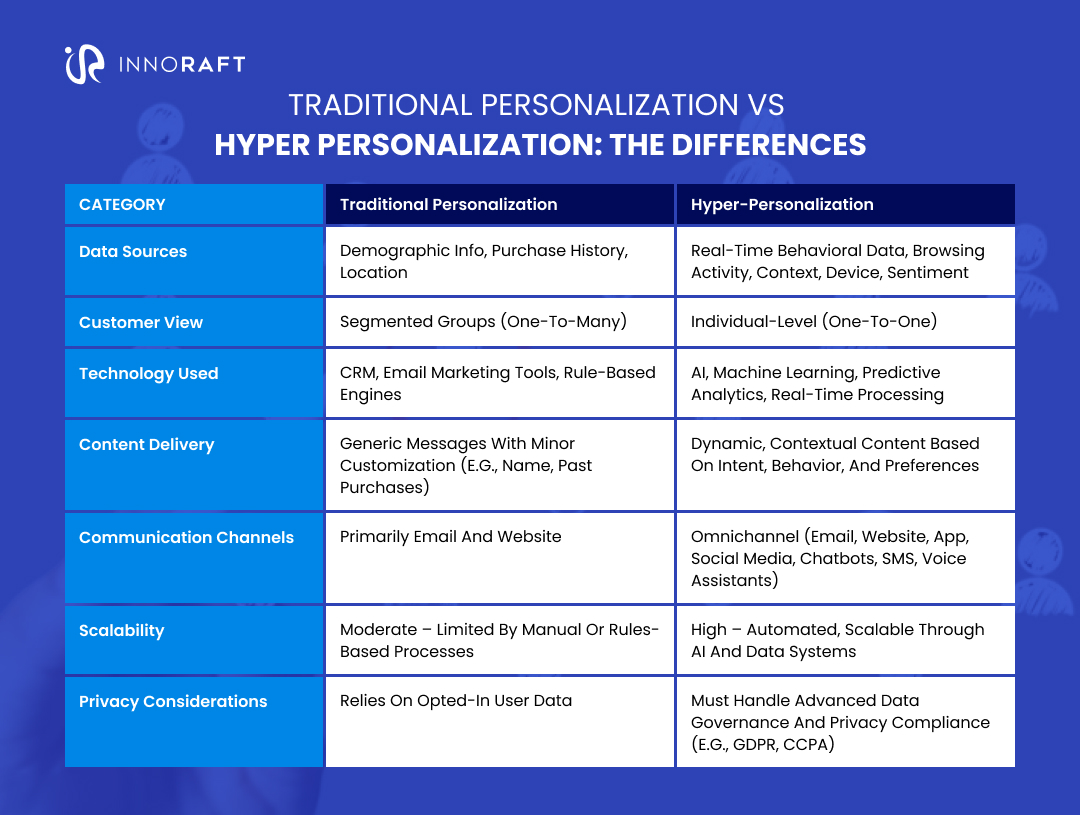Have you ever visited a website and felt like it already knew what you were looking for, showing you the right product, offering the right discounts, or displaying the right messages at the right time?
Well, that's Hyper-personalization in marketing in action.
Thanks to the vast amount of data generated daily and the advancements in the data analytics field, all businesses can now offer personalized, demographic-specific experiences. However, in a world where personalization is the norm, aligning experiences solely with demographic requirements is not enough. You need to go beyond this traditional approach and offer individual personalization- experiences that are tailored to each user's unique needs.
If you're aiming to attract, convert, and retain users in 2025, hyper-personalization isn't optional—it's essential. In the following sections, we'll break down what hyper-personalization really is, why it matters now more than ever, and how to implement hyper-personalization strategy into your customer experience seamlessly.
What is Hyper-Personalization?
So, what is hyper-personalization, and what sets it apart from traditional personalization?
At its core, Hyper-personalization in marketing is the practice of delivering highly tailored digital experiences by leveraging real-time data, behavioral insights, machine learning, and AI. Unlike basic personalization, which might involve using a user's name in an email or recommending services/products based on their purchase history or demographic data, hyper-personalization digs deeper. It adapts content, messaging, offers, and even interfaces based on individual user behavior, context, and preferences, often in real time.

Let's say a user visits your website for the third time, lingers in a specific product category, and has abandoned their cart in the past. Instead of treating them like a first-time visitor, the next time they visit the website, real-time customer personalization enables your system to dynamically serve product suggestions based on their browsing history, highlight super-relevant time-sensitive offers, and even tailor onsite messaging to nudge them toward conversion.
The various benefits of hyper-personalization are running a significant growth in the market, with studies projecting an increase from $18.49 billion in 2023 to $21.79 billion in 2024. This increase is the result of several factors, like the increase in internet usage, expansion of eCommerce, a heightened consumer expectation for personalized interactions, advancements in mobile technology, and last but not least, the broader availability of big data.
Hyper-personalization taps into a mix of data sources — think clickstreams, location data, purchase history, device usage, and even predictive analytics for customer experience — to build immersive digital or physical customer experience centers that feel uniquely tailored for each user. That level of precision is what modern users have come to expect. And as consumer expectations evolve, so must the strategies we use to engage them.
Why Hyper-Personalization Matter?
Think about the last time you ignored an ad, skipped a video, or bounced off a website. Chances are, it was not relevant to you at that time. In 2025, being simply relevant is not enough. You need to implement real-time relevance that engages customers at the right time with the right custom messaging to hook them.
Consumers today expect more than personalized subject lines or broad audience segments. They expect digital experiences that feel custom-built for them - the right place, the right time, the right message. That's exactly where hyper-personalization in marketing steps in.
But why is it so critical now?
Evolving Data Landscape
Firstly, the data landscape has evolved. With access to richer behavioral data and smarter AI tools, brands can finally move beyond guesswork and start predicting user intent with accuracy. AI-driven personalization in 2025, the technology to power hyper-personalization isn't futuristic - it's accessible, scalable, and increasingly expected.
Strong Market Competition
Secondly, the competition is fierce. Your users aren't just comparing your site to your direct competitors— they're comparing it to the best digital experiences they've ever had. If your customer journey feels generic, you risk losing attention (and conversions) to brands that are using machine learning for personalized marketing to deliver a curated experience at every touchpoint.
Trust & Security
And finally, trust matters more than ever. Today's users are more conscious of their data, and more willing to share it if it leads to genuinely useful experiences. Hyper-personalization, when done transparently and ethically, strengthens the relationship between your brand and your audience by proving that you understand their needs and respect their time.
In short, hyper-personalization isn't just a marketing trend in 2025— it's a strategic advantage. It turns data into empathy and helps you meet users not just where they are, but where they want to be.
How to Implement Hyper-Personalization Strategy?
Hyper-personalization sounds powerful in theory. But how to implement hyper-personalization strategy across your digital experience? The key is to treat it as a strategic process, not a quick fix. It requires the right infrastructure, intelligent tools, and a clear roadmap that aligns with your business goals.
Below, we've broken it down into three core phases to guide your implementation from data to delivery.
Phase 1: Build A Robust Data Foundation
Before you can personalize anything, you need to truly understand your customers, and that starts with data.
Unify Your Data Sources
Customer data is often scattered across tools and platforms- CRM systems, email platforms, data analytics, social media, and more. To get a complete picture of each user, you need to consolidate these data silos into a single actionable source of truth.
Implement A Customer Data Platform (CDP)
A Customer data platform personalization strategy acts as the backbone of your personalization strategy. It ingests data from all touchpoints, builds unified customer profiles, and makes that data accessible in real time. With a CDP in place, you can begin to move from static personalization to dynamic, behavior-driven experiences.
Establish Strong Data Governance and Prioritize Privacy
Trust is everything. With evolving regulations like GDPR and CCPA, your data practices must be transparent and compliant. Build clear governance policies, get explicit user consent, and allow users to control their data preferences. Privacy-first design isn't just ethical - it builds long-term customer loyalty.
Phase 2: Leverage AI and Machine Learning for Deep Insights
Once your data foundation is solid, it's time to unlock its value with intelligent tools.
Implement Predictive Analytics
Predictive analytics for customer experience help you anticipate customer behavior before it happens, like which users are most likely to churn, or which products a segment is most likely to buy. These insights enable proactive engagement instead of reactive guesswork.
Utilize Advanced Segmentation
Moving beyond broad demographics. AI allows you to build micro-segments based on real-time behaviors, preferences, buying intent, and contextual triggers. This level of segmentation is what powers truly personalized interactions.
Invest In A Capable AI Toolkit
Whether you're using built-in AI features in your CMS or integrating external tools, make sure your tech stack can support real-time decision making, automated content recommendations, and adaptive user flows. Look for platforms that scale with your needs and integrate seamlessly with your existing ecosystem.
Phase 3: Activate Hyper-Personalization Across The Customer Journey
With your data and insights in place, it's time to put real-time customer personalization into action across every stage of your customer journey.
Map The Customer Journey
Understand the key moments where personalization can have the biggest impact; discovery, consideration, purchase, onboarding, and retention. Each stage offers unique opportunities to deliver relevant content, offers, and messages.
Implement Real-Time Personalization Across Key Channels
Start with the high-impact touchpoints: your website, email campaigns, in-app experiences, and customer support channels. Use real-time triggers, such as page views, past purchases, or cart abandonment, to dynamically adapt messaging and offers in the moment.
Test, Learn, And Optimize Continuously
This is not a “one-and-done” process. Use hyper-personalization best practices like A/B testing analytics and customer feedback loops to refine your approach. What works today might need tweaking tomorrow. The brands that win at personalization are the ones that keep learning and iterating.
Building a hyper-personalized experience doesn't just happen overnight. But with a phased strategic approach, you'll move closer to delivering the kind of digital experiences users now expect and reward.
Ethical Consideration: Balancing Personalization with Privacy
Ethical considerations in personalization are non-negotiable in today’s privacy-conscious world. As you build tailored, data-driven experiences, it’s critical to embed transparency and respect into every interaction.
Consumers today are more privacy-conscious than ever. They are willing to share their data, but only when the value exchange is clear, the experience is respectful, and their information is handled transparently. Any kind of data misuse will damage your brand reputation.
Here are some steps you can take to ensure your hyper-personalization strategy is ethically sound:
Be Transparent About Data Usage
Let users know what data you're collecting and how you're using it, and why it benefits them. Whether it's through privacy notices, cookie banners, or preference centers, transparency builds credibility, and trust is your most valuable asset in the age of hyper-personalization in marketing.
Put Consent at The Core
Consent shouldn't be buried in the fine print. Make it easy for users to opt in, opt out, and update their preferences. Implement mechanisms that honor users' choices across platforms and interactions and avoid dark patterns that manipulate engagements.
Prioritize Data Security and Compliance
Whether you're storing behavioral insights or purchase history, your responsibility is to protect that data. Stay up to date with global privacy regulations like GDPR, CCPA, and emerging standards. Work with secure platforms and partners that share your commitment to compliance.
Avoid Over-Personalization
While real-time customer personalization is good, sometimes you might cross an invisible boundary where the personalization effort might seem invasive or overly predictive. In such cases, users might feel uncomfortable rather than impressed. The goal is relevance, not surveillance. Strike a balance between helpful and intrusive.
Champion Ethical AI
If you're using AI or machine learning for personalized marketing, ensure that your algorithms are fair, unbiased, and auditable. Bias in data can lead to discriminatory outcomes, so regularly audit your models and diversify your data sources to reflect your full audience.
Ethical personalization isn't just about risk management; it's about brand integrity. When users trust you with their data, they expect you to treat it with care. By embedding ethics into your personalization strategy, you not only meet regulatory requirements but also create a more respectful and sustainable digital experience.
Conclusion
The digital world is only getting noisier, and hyper-personalization in marketing is no longer a luxury—it’s a competitive necessity. It’s what sets apart brands that merely communicate from those that truly connect.
By combining real-time data, AI and machine learning for personalized marketing, and a thoughtful approach to customer experience, you can create journeys that feel less like marketing—and more like meaningful interactions. You’re not just optimizing for clicks; you’re building relevance, trust, and loyalty at scale.
But here’s the thing: you don’t have to overhaul everything overnight. Start by strengthening your data foundation, experiment with real-time customer personalization in one or two key touchpoints, and build from there. The tools are more accessible than ever, and the opportunity to stand out has never been greater.
So if you’re ready to create experiences your users will actually remember—and return for—hyper-personalization is the path forward.
FAQ
Frequently Asked Questions
There are multiple benefits of hyper-personalization, such as-
- Enhanced customer experience
- Increased customer engagement and loyalty
- Higher conversion rates
- Improved customer retention
- Increased customer lifetime value
Didn’t find what you were looking for here?
